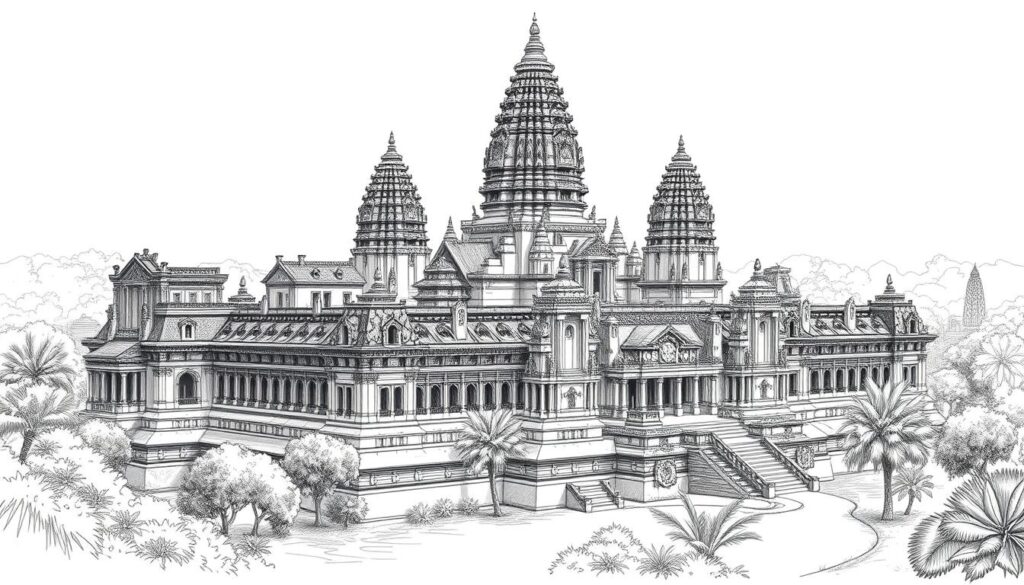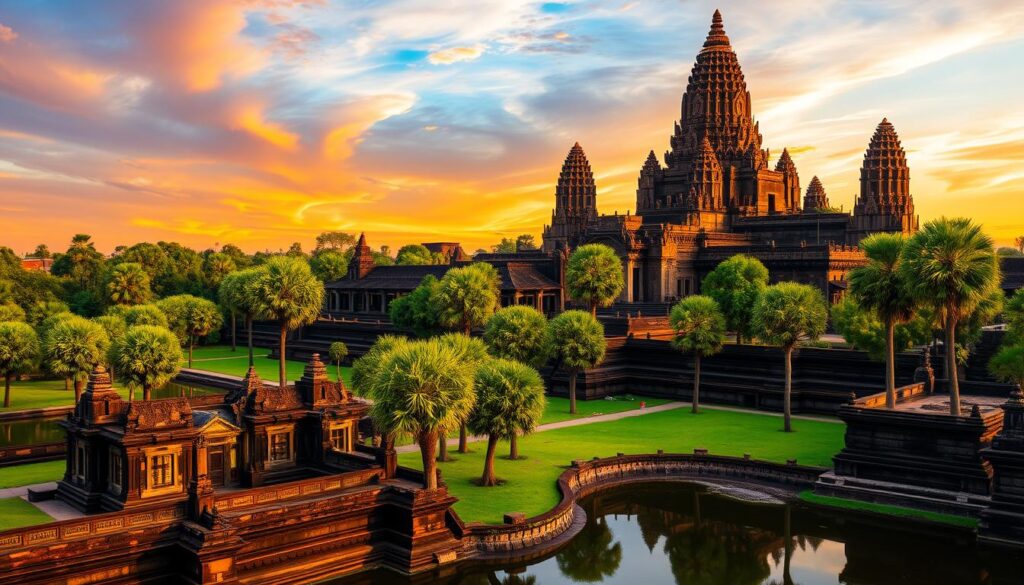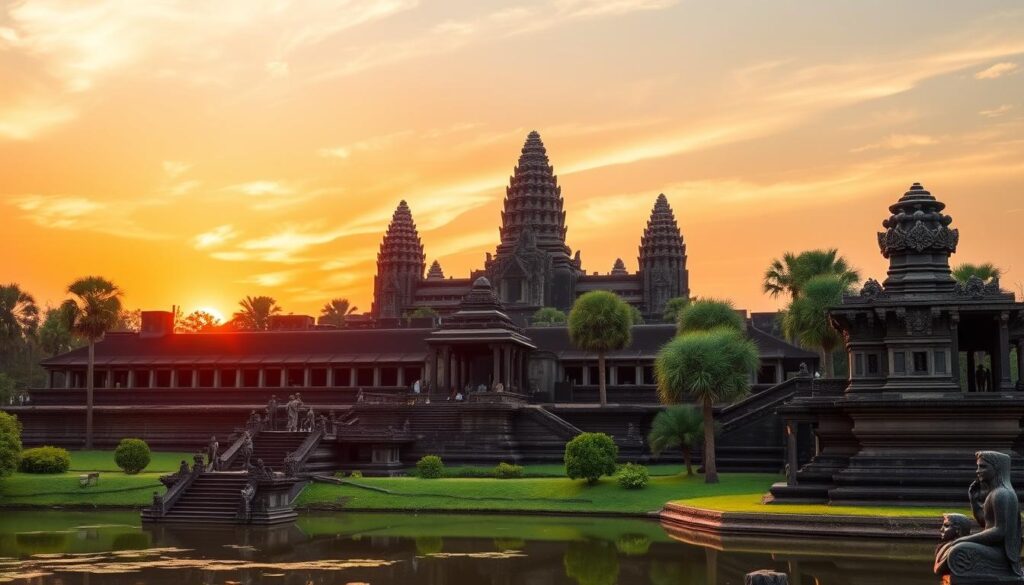
Standing before Angkor Wat, the sun’s rays highlighted the carvings. I felt awe and wonder. This ancient site in Cambodia has amazed many. It shows the Khmer civilization’s achievements.
Today, we explore Angkor Wat’s secrets and importance. It’s a UNESCO World Heritage Site. It shows human creativity and cultural strength.
Key Takeaways
- Angkor Wat is the world’s largest pre-20th-century religious building, spanning over 215m by 186m and rising over 60m tall.
- The temple was originally dedicated to the Hindu god Vishnu and later became a Buddhist temple, showcasing the religious evolution of the site.
- Angkor Wat is part of the larger Angkor Archaeological Park, which covers over 400 square kilometers and contains hundreds of surviving temples and structures.
- Recent discoveries, such as the lost city of Mahendraparvata, continue to shed light on the remarkable engineering and urban planning of the Khmer civilization.
- Angkor Wat faces modern challenges, including mass tourism and environmental threats, underscoring the importance of preservation efforts to protect this iconic landmark.
The Historical Significance of Angkor Wat
Angkor Wat is the largest religious monument in the world. It shows the grandeur and power of the Khmer empire. Built in Cambodia, it was made during Suryavarman II’s rule from 1113 to 1150 CE.
Building it was a huge task. About 300,000 workers worked on it for many years.
Origins of the Khmer Empire
The Khmer empire was at its peak in the 12th century. Angkor Wat was its heart, where politics, economy, and religion met. Its design, inspired by Hindu mythology, shows the Khmer people’s culture and beliefs.
Religious and Cultural Importance
Angkor Wat is more than just a building. Its walls have thousands of bas-reliefs of gods and stories from Hindu and Buddhist faiths. The Churning of the Ocean of Milk is a key story here. Today, it’s a symbol of Cambodia and a place of worship for Buddhists.
Architectural Achievement
Angkor Wat’s design is amazing. It covers over 400 acres, making it the largest religious site. The central part, with five towers, is like Mt. Meru from Hindu myths. Its design is both beautiful and meaningful.
“Angkor Wat remains an important symbol for the Cambodian nation and Buddhists worship at the site.”
Cambodia’s Angkor Wat: Uncovering Ancient Temples
Recent surveys, including LiDAR technology, have changed how we see Angkor Wat. It was once thought to be just a temple. Now, we know it was at the center of a large city. The LiDAR survey found new structures within the temple complex.
In 2008, French archaeologist Jean-Baptiste Chevance started digging at Kulen, a mountain near Angkor Wat. By 2012, Chevance and Damian Evans used LiDAR to uncover hidden structures. Their 2019 findings showed the layout of Jayavarman’s capital, expanding our knowledge of the Angkor civilization.
Discoveries of ancient temples and stone carvings have enriched our understanding of the Angkor civilization. They’ve also created new tourism opportunities in Cambodia. Kulen is becoming a new tourist spot, while Angkor Wat remains a top attraction, even during the pandemic.
| Fact | Statistic |
|---|---|
| Angkor Wat annual visitors before COVID-19 | Over 2.5 million |
| Estimated population of the capital city of Greater Angkor at its peak | 700,000-900,000 people |
| Size of the Angkor Wat temple complex | 215m x 186m, rising more than 60m above the surrounding land |
| Area of the moated enclosure walls of Angkor Wat | 1,500m x 1,200m |
| Area of Greater Angkor, the region around Angkor Wat | Estimated 1,000 km² |
The discovery of ancient temples and stone carvings in Angkor has deepened our understanding of the Angkor civilization. It has also opened up new tourism and cultural preservation opportunities in Cambodia.
The Architectural Marvel of Angkor Wat Complex
Angkor Wat is a stunning example of ancient Cambodian builders’ skill. It’s a huge religious site, covering over 200 hectares. It shows the cosmic world of Hindu myths.
The central tower is Mount Meru, the gods’ home. The four smaller towers are its peaks. The temple walls are the mountains at the world’s edge. The moat is the cosmic ocean.
Temple Design and Construction
Building Angkor Wat started in the early 12th century. It was a huge engineering task. 6,000 elephants and many workers moved and placed massive sandstone blocks, some over 1.5 tons.
The temple has three galleries that go up. The central tower is 65 meters tall.
Sacred Geometry and Symbolism
Angkor Wat’s design is full of symbols. It shows the site’s deep religious and cultural importance. The layout and carvings, like scenes of history and myths, are very meaningful.
Many see Angkor Wat as a heavenly creation. Its size and beauty make it stand out.
Building Techniques and Materials
Angkor Wat was built with sandstone, brick, and laterite. Sandstone was the main material, with some blocks being 1.5 tons. The stones were moved by rafts on canals and elephants.
Angkor Wat amazes visitors from all over. It welcomes over 2.5 million tourists each year. This Khmer religious site shows the ancient Cambodian culture’s creativity and richness.
Life Within the Temple Walls
The grandeur of the Angkor civilization shines in its religious monuments and temples. But it also shows in the lively daily life inside these structures. Thousands of people worked in the temples, and many more helped with food and services. They supported the spiritual and administrative heart of the Khmer empire.
Inscriptions and bas-reliefs give us a peek into temple life. They show court scenes, battles, and religious ceremonies. These ancient records reveal the lives of the elite who lived in Angkor.
The temple was more than a place of worship. It was also the center of the empire’s administration. This shows how important the temples were to the Khmer people. They saw the temples as sacred and the heart of their civilization.
| Key Facts about Life in Angkor | Statistics |
|---|---|
| Angkor Wat is the largest religious monument in the world | — |
| Angkor Wat transformed from a Hindu to a Buddhist site | — |
| Ta Prohm temple was featured in the movie “Tomb Raider” | — |
| Artisans d’Angkor workshop showcases traditional crafts of Cambodia | — |
| Skilled artisans create intricate stone carvings and lacquerware in Cambodia | — |
“The temple served as a center for both spiritual and administrative activities in the Khmer empire.”
The Lost City of Mahendraparvata
The ancient city of Mahendraparvata lies hidden in the Phnom Kulen plateau. It’s a key find in Cambodia, showing the start of the Angkor civilization. This city was before Angkor Wat, a famous site.
Archaeological Discoveries
LiDAR technology helped find thousands of ancient features over 20 square miles. It showed a complex grid of dikes, linking reservoirs, temples, and a palace. This proves Mahendraparvata was the Khmer Empire’s first capital.
Its design influenced later cities like Angkor. This shows how advanced the city’s planning was.
Modern Excavation Methods
- LiDAR technology has been key in revealing Mahendraparvata’s secrets, mapping it in great detail.
- The team found a big water management system that was never finished. It might have led to the city’s decline.
- Mahendraparvata was founded before Angkor, with power moving to Angkor around 900 A.D.
Discovering Mahendraparvata sheds light on the Angkor civilization’s beginnings. It’s a major find in ancient history. As more is learned, the Khmer Empire’s story grows, exciting scholars and tourists.
Ancient Engineering and Water Management
The Khmer civilization built Angkor Wat with advanced water systems. These systems included reservoirs, canals, and irrigation channels. They helped support the large population of the Angkor Empire.
The water management system covered about 1,000 square kilometers. It was built between the 8th and 14th centuries. It had many parts, like east-west embankments, north-south channels, and large reservoirs (barays).
The system had three main areas. The northern zone was for water distribution. The central zone had major barays and temple moats for water storage. The southern zone was for water disposal and distribution. The great barays were at the heart of this network, serving both practical and symbolic purposes.
“The Khmer Empire dominated Southeast Asia from the 9th to the 15th centuries; Angkor Wat is considered one of the most important religious centers in Southeast Asia.”
The northern collector system helped slow down and spread monsoon water. The disposal and distributor channels took water to the lake or spread it across the landscape. This system showed the Khmer architecture and the Angkor civilization’s ingenuity.
| Key Components of the Angkor Water Management System | Purpose |
|---|---|
| East-west embankments | Water distribution |
| North-south channels leading to large reservoirs (barays) | Water storage |
| Barays and temple moats | Water storage |
| Embankments and channels oriented from northwest to southeast | Water distribution |
| Channels oriented towards the southwest for rapid water disposal | Water disposal |
Religious Transformation Through Ages
Angkor Wat, the famous Hindu-Buddhist temple and religious site, has seen a big change over time. It was first built for the Hindu god Vishnu in the 12th century. Later, it became a Theravada Buddhist shrine in the 15th century.
Hindu Origins
Angkor Wat started as a Hindu place of worship. Its design and carvings show this. The temple’s layout is like Mount Meru, the mythical home of Hindu gods.
The carvings and statues tell stories from the Ramayana and Mahabharata. These are two key Hindu epics.
Buddhist Conversion
The change from Hindu to Buddhist was due to Theravada Buddhism’s growth. King Jayavarman VII and more Buddhist monks led this change. Angkor Wat was updated with new statues and uses.
Even with these changes, Angkor Wat kept its spiritual value. From the 16th to 18th centuries, it was still revered. Today, it shows how different religions can coexist and the rich Khmer culture.
“Angkor Wat covers an area of over 400 acres, making it the largest religious monument globally, and the moat surrounding the main temple stretches for over 3 kilometers, enhancing the grandeur of this iconic Hindu-Buddhist temple.”
Preservation and Conservation Efforts
The UNESCO World Heritage Site of Angkor Wat faces many challenges. These include structural issues, erosion, and damage from tourists. Since the late 20th century, UNESCO and national teams have worked hard to save this temple complex.
They focus on strengthening the structure, restoring stone carvings, and caring for the forest and water. New technologies, like LiDAR scanning, have helped uncover hidden parts of Angkor. This has changed how we see its urban landscape.
| Preservation Efforts | Key Achievements |
|---|---|
| Structural Reinforcement | Stabilizing the foundations and walls of the temples to prevent further deterioration |
| Restoration of Stone Carvings | Meticulous conservation of the intricate stone carvings that adorn the temple walls |
| Landscape Management | Maintaining the surrounding forests, waterways, and infrastructure to preserve the site’s delicate ecosystem |
Keeping Angkor Wat safe while allowing tourists is a big challenge. Cambodia and the world work together to protect this cultural gem. Their efforts ensure it remains a wonder for future generations.
“The preservation of Angkor Wat is not just about restoring the physical structures; it’s about safeguarding the cultural and spiritual essence of this extraordinary site.”
Modern Tourism and Cultural Impact
Angkor Wat, a famous UNESCO World Heritage Site in Cambodia, attracts over 2.5 million visitors each year. Before the COVID-19 pandemic, it was a top spot for travelers. The rise in tourists has greatly affected the local economy and culture of Siem Reap province.
The area’s economy has grown thanks to tourism. Yet, the large number of visitors has made it hard to protect this cultural treasure. The Apsara Authority works hard to keep the site safe while still welcoming visitors.
Visitor Experience
Visitors are amazed by Angkor Wat’s Khmer architecture. They see detailed carvings, tall spires, and symbols from the sky and earth. The main tower is the tallest religious monument globally, reaching 213 feet.
To make visits better, the Apsara Authority limits the number of people. They also control where visitors can go and offer educational materials. This helps people understand the site’s history and culture.
Local Community Connection
The people of Siem Reap are now more involved in managing Angkor Wat. They work together to make sure tourism benefits everyone. They also focus on keeping the ancient temples and Khmer architecture safe.
The Apsara Authority supports local guides, artisans, and businesses. This helps build a strong bond between Angkor Wat and the community. It makes people proud of this UNESCO World Heritage Site.
“Angkor Wat is not just a tourist destination; it is a living, breathing embodiment of Cambodia’s rich cultural heritage. By involving the local community, we can ensure that this treasure is preserved for generations to come.”
– Apsara Authority representative
Conclusion
Angkor Wat is a marvel of Khmer architecture, drawing people from all over. New discoveries, like using Lidar technology, are changing how we see this ancient place. It’s a key symbol for Cambodia, showing the need for ongoing research and care.
With over 2.3 million visitors in 2014, Angkor Wat is a big tourist attraction. But, we must protect it from too many visitors. Efforts to fight climate change and involve local people are key to keeping it safe for the future.
Exploring places like Angkor Wat shows the Khmer people’s strength and creativity. This UNESCO World Heritage Site has faced many challenges but still stands strong. As we learn more about it, we’re inspired to keep it safe for future generations.












